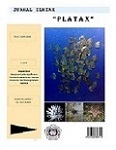Phytoplankton Composition and Factors Of Physics – Chemical Water Depth On Water Lake Tondano
DOI:
https://doi.org/10.35800/jip.4.2.2016.13876Abstract
Research on phytoplankton composition and physico-chemical factors of the Central part of Tondano waters was done by taking water samples from the depths of 5 M, 10 M and 20 M, respectively. The purpose of the study was to identify the phytoplankton, determine the species density and diversity index, and the physico-chemical factors of water with depth.
Results revealed that 8 species of phytoplantkon were found at 8 m depth dominated by Chlorophyceae (2 species with 228 cells/liter), and Bacillariophyceae (3 species with 168 cells / liter). Thirteen species were recorded at 10 m depth dominated by Clorophyceae (7 species with 1728 cells / liter), and Bacillariophyceae (3 species with 984 cells / liter). Meanwhile, there were 8 species found at 20 m depth dominated by Bacilariophyceae (4 species with 3828 cells / liter) and Chlorophyceae (one species with 84 cells / liter).
The results of the analysis of the ecological index at a water depth of 5 m to 20 meters earn variation of species diversity index (H ', H'miax, H'min) with a value of 1779-1039, 1832-1069, 1707-1008), the dominance index (D) with value of 0.204 - 0.4722, and harmony with the index value of 0.7406 - 0.3535.Based on t-test, species diversity index(H) of the phytoplankton at all 5 M depth was not different from that at 10 M), but the spesies diversity index was different between 5 M and 20 M depth and between 10 M and 20 M.
The results of measurements of chemical physics parameters of water at a depth of 5 M to 20 M has a range of concentrations (TDS 149- 151 mg / L, DHL 232-234 mg / L, pH 7.2 - 6.79, Total Phosfat 0.0008 - 0.062 mg / L, dissolved Phosfat 0.0 mg / L, Total Nitrogen 0065-0027 mg / L, Ammonia 0031-0012 mg / L, and Nitrate 0.83 - 1.70 mg / L
Keyword : Tondano Lake, Phytoplankton, Density
Â
ABSTRAK
Penelitian tentang komposisi fitoplankton dan faktor fisika-kimia dari bagian Tengah perairan Tondano dilakukan dengan mengambil sampel air dari kedalaman masing – masing 5 M, 10 M dan 20 M. Tujuan dari penelitian ini adalah untuk mengetahui komposisi dan kepadatan populasi phytoplankton, indeks-indeks ekologi, dan faktor lingkungan fisik kimia perairan berdasarkan kedalaman air.
Hasil penelitian menunjukkan bahwa 8 spesies fitoplankton ditemukan pada kedalaman 8 m didominasi oleh Chlorophyceae (2 spesies dengan 228 sel / liter), dan Bacillariophyceae (3 spesies dengan 168 sel / liter). Tiga belas spesies tercatat di kedalaman 10 m didominasi oleh Clorophyceae (7 spesies dengan 1.728 sel / liter), dan Bacillariophyceae (3 spesies dengan 984 sel / liter). Sementara itu, ada 8 spesies yang ditemukan pada kedalaman 20 m didominasi oleh Bacilariophyceae (4 spesies dengan 3828 sel / liter) dan Chlorophyceae (satu spesies dengan 84 sel / liter).
Hasil analisis indeks ekologi pada kedalaman air 5 m sampai 20 meter mendapatkan variasi Indeks keanekaragaman spesies (H’, H’miax, H’min) dengan nilai 1.779 – 1.039, 1.832 – 1.069, 1.707 – 1.008), indeks dominasi (D) dengan nilai 0.204 – 0.4722, dan indeks keserasian dengan nilai 0.7406 – 0.3535. Berdasarkan t-tes, indeks keanekaragaman spesies (H) dari fitoplankton di semua kedalaman 5 M tidak berbeda dengan 10 M), tetapi indeks spesies keanekaragaman berbeda antara kedalaman 5 M dan 20 M dan antara 10 M dan 20 M.
Hasil pengukuran parameter fisika kimia perairan pada kedalaman 5 M sampai 20 M mempunyai kisaran konsentrasi (TDS 149- 151 mg/L, DHL 232 – 234 mg/L, pH 7.2 – 6.79, Total Phosfat 0.0008 – 0.062 mg/L, Phosfat terlarut 0.0 mg/L, Total Nitrogen 0.065 – 0.027 mg/L, Amoniak 0.031 – 0.012 mg/L, dan Nitrat 0.83 – 1.70 mg/L
Kata kunci : Danau Tondano, Fitoplankton, Kepadatan
1 Mahasiswa Program Studi Manajemen Sumberdaya Perairan, FPIK Unsrat
2 Staf Pengajar Program Studi Manajemen Sumberdaya Perairan, FPIK Unsrat
Downloads
Published
How to Cite
Issue
Section
License
COPYRIGHT
Authors who publish with this journal agree to the following terms:
Authors hold their copyright and grant this journal the privilege of first publication, with the work simultaneously licensed under a Creative Commons Attribution License that permits others to impart the work with an acknowledgment of the work's origin and initial publication by this journal.
Authors can enter into separate or additional contractual arrangements for the non-exclusive distribution of the journal's published version of the work (for example, post it to an institutional repository or publish it in a book), with an acknowledgment of its underlying publication in this journal.
Authors are permitted and encouraged to post their work online (for example, in institutional repositories or on their website) as it can lead to productive exchanges, as well as earlier and greater citation of the published work (See The Effect of Open Access).




















